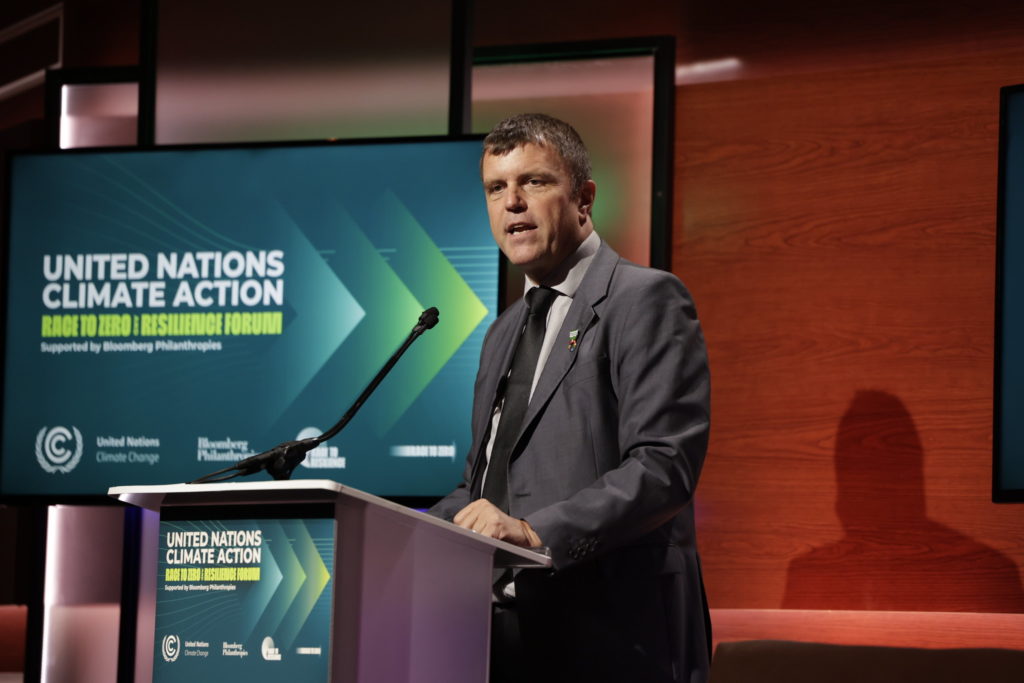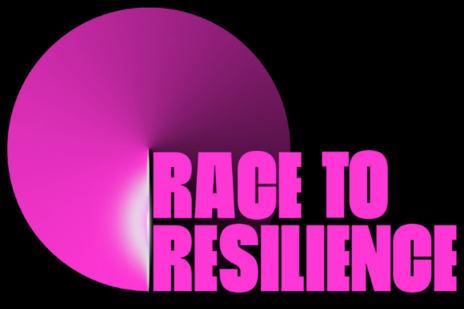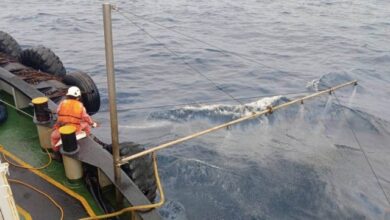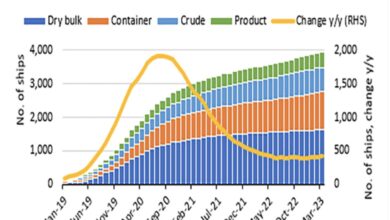Race to Resilience and Race to Zero Forum : A new era of climate regulation

UN Climate Change High-Level Champions launched Adaptation and Resilience Breakthroughs, which define 11 common goals to make 4 billion climate vulnerable people more resilient to climate hazards by 2030.
In addition, publication of a new report, The Pivot Point, co-authored with 40+ expert groups, identifying the types of rules and standards needed to shift from voluntary climate action to standardized and regulated action to enable committed companies to deliver net zero, faster.
First ever ‘progress report’ for the Race to Zero and Race to Resilience campaigns, providing an honest stocktake of the extent and pace of action so far.
At today’s United Nations Climate Action: Race to Zero and Race to Resilience Forum, the UN Climate Change High-Level Champions for COP26 and COP27, Nigel Topping and Dr. Mahmoud Mohieldin — in collaboration with Bloomberg Philanthropies — convened business, finance, government, civic and cultural leaders to make good on the raft of climate commitments that have been made.
Hosted at the Plaza Hotel during the UN General Assembly and Climate Week in New York City, the Forum focussed on closing the ‘implementation gap’ by ensuring voluntary climate commitments translate into progress, drive towards standards and regulation, and put adaptation and resilience at the heart of climate action.
Positioned ahead of the upcoming UN Climate Conference (COP27) in Sharm El Sheikh, the Champions launched three landmark products: The Adaptation and Resilience Breakthroughs, the Pivot Point Report, and the Progress Report for the Race to Resilience and Race to Zero campaigns.

UN Climate Change High-Level Champion for COP27, Dr. Mahmoud Mohieldin said: “We are proud to launch the Adaptation and Resilience Breakthroughs today because we know that reducing climate action to mitigation or decarbonization only is a formula for failure. Adaptation, loss and damage and finance are critical urgent interventions and we need to see some ambition, scale-up and fulfillment of pledges on these fronts.”

UN Climate Change High-Level Champion for COP26, Nigel Topping said: “Net zero targets now cover over 90% of the global economy yet global progress to limit temperature rise to 1.5C remains inadequate. We cannot rely on voluntary action alone to get us there. It’s time for a pivot where, together with the Marrakech Partnership, we define cooperation between governments, regulators and the private sector to correct market failures and provide enabling regulatory environments to dramatically accelerate transformation to a 1.5C-aligned economy.”
Goals to turbocharge adaptation and resilience
The summit saw the launch of the ‘Adaptation and Resilience Breakthroughs’, which define 11 common goals to accelerate adaptation action and increase resilience to climate hazards, such as floods, droughts, and lethal heat.
These goals cover food and agriculture, oceans, water, human settlements and infrastructure systems to protect 4 billion people living in the most climate-vulnerable coastal, rural and urban communities by 2030.
Together, the Breakthroughs set out for the first time an initial set of eleven measurable and high impact outcomes for international initiatives to coalesce behind, including:
- Transitioning to climate resilient, sustainable agriculture that can increase yields by 17%, without expanding agricultural frontiers, improving livelihoods including of smallholder farmers
- Halving the share of food production lost, and halving per capita food waste (relative to 2019).
- Smart and early warning systems to reach 3 billion people
- 10,000 cities have evidence-based, actionable adaptation plans
- Protecting 45 m ha lands and inland waters; 2 bn ha sustainable management and 350 m ha restoration of land, securing indigenous rights and local communities with use of nature-based solutions to improve water security and livelihoods.
- USD 4 billion invested to secure the future of 15 million hectares of mangroves globally, through collective action on halting mangrove loss, restoring half of recent losses, doubling protection of mangroves globally and ensuring sustainable long-term finance for all existing mangroves, leading to increased resilience of coastal communities to storms and enhanced livelihoods.

These goals mirror the sectoral Race to Zero breakthrough goals launched last year for mitigation.
Anchored with leading Partners, these are intended to crowd in additional effort, action and resource around shared goals. Example breakthroughs include:
- With the Extreme Heat Resilience Alliance and Climate Resilient Housing, ensure 1 billion people have better design, construction and access to finance to live in decent, safe homes
- WIth the Global Mangroves of Alliance to spearhead the protection and restoration of 15 m ha of global mangroves.
- With C40 and the International Transport Workers Federation, ensure 2.2 billion people access low-cost, clean vehicles and mobility solutions through the expansion of affordable public and private transport services.
The ‘Adaptation and Resilience Breakthroughs’ can be found here, and the accompanying article can be found here.

A shift from voluntary to regulated climate action
In addition, the Climate Champions published a new report setting out the steps needed to pivot from an over-reliance on voluntary action. Drawing on expertise from 40+ organisations, the report offers insights on how to rapidly convert voluntary action into adequate standards, policies and regulations needed to achieve the mitigation goal of the Paris Agreement.
Key highlights from the report include:
- Overview of the current landscape across the voluntary climate leadership initiatives, and emerging standards and regulations. From international standards such as ISO to international trade to competition law, the report maps standards, policies and regulations needed to resolve confusion, create level playing fields, align incentives and reward investment, tackle greenwash, and correct market failures.
- A ‘call to action’ for all non-state actors to join the Race to Zero; ratchet their policy engagement; and help inform, shape and drive the standards, policies and regulations needed to align with 1.5C.
The Pivot Point report can be found here.
‘Progress Report’ for the Race to Zero and Race to Resilience – an honest assessment of progress
The Progress Report marks the first time the UN-backed global climate campaigns, Race to Zero and Race to Resilience, have published a stocktake of progress. The Report shows the progress of the more than 13,000 businesses, financial institutions, cities, states, and regions.
Highlights for the Race to Zero campaign include:
- There are now 11,309 organizations in 116 countries in the campaign, which represents a doubling of members since last September. More than 1-in-8 of the world’s population is represented by commitments from City and Regional Governments.
- The report showcases the regional diversity of the campaign’s members – from regions in Korea, corporates in Brazil, SMEs in Spain, Universities in Pakistan to wineries in Chile – taking action to reduce emissions this decade. Since July this year, the campaign has seen a 30% increase of members in the Asia-Pacific – the fastest growing region in that period.
- Members are taking action and reporting on progress. The report includes analysis of a subset of the larger corporations reporting progress to CDP, which shows that 77% of these have transition plans in line with 1.5C, 98% are proceeding with immediate action and about 68% have publicly committed to align their policy engagement with their net zero commitments
- Meanwhile, more than three-quarters of cities and almost nine in ten subnational governments have a climate action plan and have shared it publicly.
Highlights for the Race to Resilience campaign include:
- There are now 34 Partner Initiatives in 139 Countries which have joined the Race to Resilience, spanning every continent. Together, they are working towards a shared goal of increasing resilience for 4 Billion people in vulnerable communities.
- The Race to Resilience campaign, alongside its Partners, now spans all six Marrakech Partnership action areas from the Resilience Pathway, such as the leveraging of financial resources for resilience and adaptation, nature-based solutions and early warning systems/early action













